Energy Efficient Triple Glazed Windows
Triple Glazed Windows
The Most Energy Efficient Window Available

Save $100’s in Energy and costs and feel more comfortable all year round!
The main benefit of replacing your windows is the increased energy efficiency and comfort you will enjoy. This means large savings of $100 each and every year. The right windows for you will provide you with the maximum savings and benefits.
At Encore we promise “you will know which windows are best for you and why before you buy.” Making the right decision now will provide you with benefits for as long as you own your home. We will provide you with all the information you need to make an informed decision.
Introducing…
…the absolute warmest and strongest insulating system on the market today.
Exclusively offered to you by VWD.
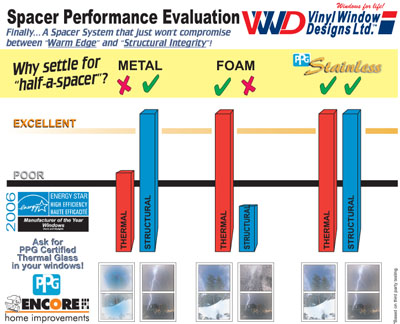
Compare the difference…
…between a regular new window and our space age triple glazed super window with the exclusive stainless steel system.
Simply the warmest and most efficient window available today.
We Have the Right Glass for You! Hot or Cold!


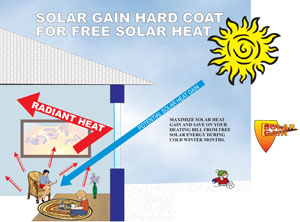

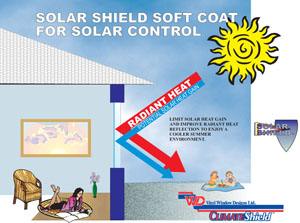
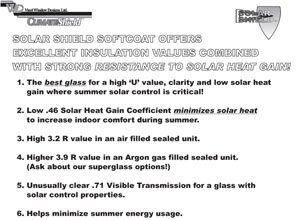
Energy & Cost Savings
The following information is an example of energy and cost savings.

Heating Season Savings
In climates with a significant heating season, windows have represented a major source of unwanted heat loss, discomfort, and condensation problems. In recent years, windows have undergone a technological revolution. It is now possible to have lower heat loss, less air leakage, and warmer window surfaces that improve comfort and minimize condensation. The graph below illustrates the significant savings in heating season costs associated with energy efficient windows for a house in a heating-dominated climate. In cold regions, this means that windows are no longer an energy loser to be avoided — increasing glazing area with high performance windows can have little or no affect on total energy use.


Cooling Season Savings
In climates that mainly require cooling, windows have represented a major source of unwanted heat gain. In recent years, windows have undergone a technological revolution. It is now possible to significantly reduce solar heat gain and improve comfort while providing clear views and daylight. The graph below illustrates the significant savings in cooling season costs associated with improved windows for a house in a cooling-dominated climate. In warm regions, this means that high performance windows can face into the sun if desired without great energy penalties — although shading techniques remain important.

Improved Comfort
High performance windows with new glazing technologies not only reduce energy costs but make homes more comfortable as well. Source: Lawrence Berkeley National Laboratory (Lyons and Arasteh)
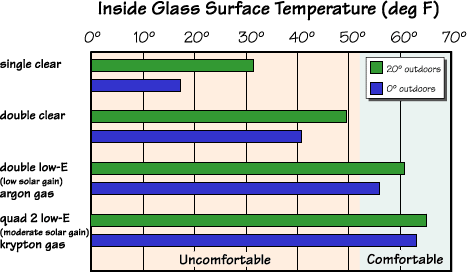

Winter Thermal Comfort
An older window with a lower glass temperature feels colder because more heat is radiated from a person’s body to the window. Cold glass can also create uncomfortable drafts as air next to the window is cooled and drops to the floor. This sets up an air movement pattern that feels drafty and accelerates heat loss. High performance windows with lower U-factors will result in a higher interior window temperature in winter and thus greater comfort. Proper installation along with weatherstripping designed to seal tightly (for operable windows) will also improve comfort by reducing cold air leakage.
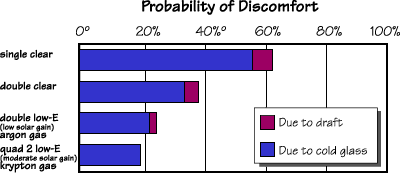
Source: Lawrence Berkeley National Library (Lyons and Arasteh)

Summer Thermal Comfort
In summer, strong direct sunlight strikes people and interior surfaces, creating overheating and discomfort. Windows with low solar heat gain coefficients will reduce the solar radiation coming through the glass and associated discomfort. Low solar heat gain low-E glass (spectrally selective) reduces heat gain while still providing sufficient light and view.
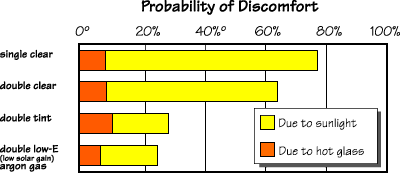
Source: Lawrence Berkeley National Laboratory (Lyons and Arasteh). Benefits: Less Condensation
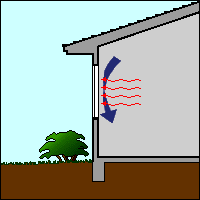
High performance windows with new glazing technologies not only reduce energy costs but make homes more comfortable as well.
High-performance windows create warmer interior glass surfaces, reducing frost and condensation. High-performance windows with warm edge technology and insulating frames have such a warm interior surface that condensation on any interior surfaces is significantly reduced under all conditions.
Impact of Low-E Glass and Insulating Spacers on Condensation

Source: Lawrence Berkeley National Laboratory
The adjacent images show interior surface temperature patterns of a clear double glazed unit (left) and an energy-efficient Low-E insulated glazing unit with an improved spacer (right). Under typical winter conditions, (i.e. 20°F outside), condensation on the glass under typical humidity levels is shown by purple and blue. With a conventional clear double glazing (left), condensation occurs in a band a couple inches wide along the edge of the sightline, with more condensation along the bottom than at the top. With the energy-efficient Low-E insulated glass unit (right), condensation will be greatly reduced (a small strip less then 1″ high along the bottom). Under extreme winter conditions (i.e. 0°F outside), condensation is shown by purple, blue and green. With clear double glazing, there is condensation over the entire unit. With energy-efficient Low-E glazing, there is only condensation on a band along the bottom and up along the edges.
Impact of Temperature, Humidity and Glass Choice on Center-of-Glass Condensation
The graph shows condensation potential on the center of glass area (the area at least 2.5″ from the frame/glass edge) at various outdoor temperature and indoor relative humidity conditions. Condensation can occur at any points that fall on or above the curves. As the U-factor of windows improve, there is a much smaller range of conditions where condensation will occur.
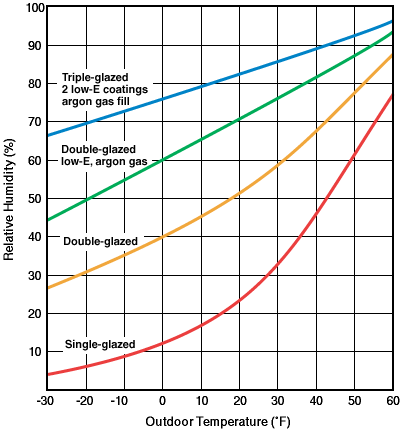
Source: Lawrence Berkeley National Laboratory. These values are based on center-of-glass temperatures. Condensation may occur at lower humidity levels on the glass edge.

